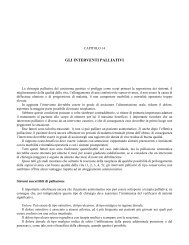Evidence-based medicine in the treatment of ... - Alfredo Garofalo
Evidence-based medicine in the treatment of ... - Alfredo Garofalo
Evidence-based medicine in the treatment of ... - Alfredo Garofalo
Create successful ePaper yourself
Turn your PDF publications into a flip-book with our unique Google optimized e-Paper software.
All patients will receive three cycles <strong>of</strong> plat<strong>in</strong>um-<strong>based</strong> <strong>the</strong>rapy as set by <strong>the</strong><br />
pr<strong>in</strong>cipals <strong>of</strong> <strong>the</strong> MAGIC trial (Figure 3), followed by D2 resection. Patients will be<br />
<strong>the</strong>n randomized ei<strong>the</strong>r to undergo surgery with HIPEC or surgery alone.<br />
Cl<strong>in</strong>ical trials: Ovarian cancer<br />
Ovarian cancer is a major heath problem worldwide, with an estimated 205,000<br />
new cases year [17]. Therapy for OC is dependent on <strong>the</strong> stage <strong>of</strong> diagnosis. Most <strong>of</strong><br />
<strong>the</strong> cases are diagnosed at advanced stage <strong>of</strong> disease [97]. Therefore, <strong>the</strong>rapy for<br />
newly many diagnosed OC cases (frontl<strong>in</strong>e <strong>the</strong>rapy) <strong>in</strong>cludes SRC followed by<br />
systemic <strong>the</strong>rapy comb<strong>in</strong><strong>in</strong>g plat<strong>in</strong>um compound and taxens [98-102]. For those<br />
patients for whom primary surgery is not feasible, primary chemo<strong>the</strong>rapy is given,<br />
followed by <strong>in</strong>terval debulk<strong>in</strong>g after 3 cycles <strong>of</strong> <strong>the</strong>rapy. However, 60-70% <strong>of</strong> patients<br />
will suffer disease recurrence [98-99]. The two most frequent recurrence patterns are<br />
locoregional (lymph node) recurrence or peritoneal dissem<strong>in</strong>ation. Cytoreductive<br />
surgery may be applied as frontl<strong>in</strong>e <strong>the</strong>rapy, <strong>in</strong>terval debulk<strong>in</strong>g or at <strong>the</strong> time <strong>of</strong><br />
recurrence. The pr<strong>in</strong>cipal goal <strong>of</strong> cytoreductive surgery is to remove all <strong>of</strong> <strong>the</strong> primary<br />
disease and, if possible, all metastatic disease s<strong>in</strong>ce <strong>the</strong> size <strong>of</strong> <strong>the</strong> rema<strong>in</strong><strong>in</strong>g disease<br />
is related to survival [103,104]. The high percentage <strong>of</strong> recurrent disease despite<br />
optimal <strong>treatment</strong> can be expla<strong>in</strong>ed by residual tumor nodules rema<strong>in</strong> follow<strong>in</strong>g CRS<br />
resistant to systemic chemo<strong>the</strong>rapy.<br />
Intraperitoneal chemo<strong>the</strong>rapy is attractive for <strong>the</strong> <strong>treatment</strong> <strong>of</strong> ovarian<br />
carc<strong>in</strong>oma, which rema<strong>in</strong>s conf<strong>in</strong>ed to <strong>the</strong> peritoneal cavity for most <strong>of</strong> its natural<br />
history. In a phase III cl<strong>in</strong>ical trial (GOG 172) reported by Armstrong et. Al, [24] IP<br />
chemo<strong>the</strong>rapy comb<strong>in</strong>ed with <strong>in</strong>tra-venous <strong>the</strong>rapy was shown to be superior to<br />
systemic chemo<strong>the</strong>rapy alone. Ca<strong>the</strong>ter related problems rema<strong>in</strong> <strong>the</strong> highest obstacle<br />
for EPIC or DPIC as shown by ano<strong>the</strong>r report <strong>of</strong> <strong>the</strong> same cl<strong>in</strong>ical trial [105]. Fiftyeight<br />
percent <strong>of</strong> <strong>the</strong> patients did not complete six cycles <strong>of</strong> IP <strong>the</strong>rapy. Thirty-four<br />
percent <strong>of</strong> <strong>the</strong>se patients discont<strong>in</strong>ued IP <strong>treatment</strong> due to ca<strong>the</strong>ter related<br />
complications. Altoge<strong>the</strong>r, postoperative <strong>in</strong>traperitoneal chemo<strong>the</strong>rapy was shown by<br />
three randomized controlled trials, to result <strong>in</strong> an overall and progression-free survival<br />
benefit when cisplat<strong>in</strong> is adm<strong>in</strong>istered by <strong>the</strong> IP route <strong>in</strong> patients with stage III,<br />
optimally resected disease [24,100,101]. In <strong>the</strong> study reported by Alberts et al [100]<br />
optimally debulked patients (n=546) with stage III ovarian carc<strong>in</strong>oma were<br />
randomized between <strong>in</strong>tra-venous cycl<strong>of</strong>osphamide and cisplat<strong>in</strong> versus <strong>in</strong>tra-venous<br />
cycl<strong>of</strong>osphamide and IP cisplat<strong>in</strong> (100 mg/m2). An estimated median survival <strong>of</strong> 41<br />
vs. 49 months was achieved <strong>in</strong> favor <strong>of</strong> <strong>the</strong> IP treated group. In <strong>the</strong> study reported by<br />
Markman et al [101], patients (n=462), with optimally debulk<strong>in</strong>g surgery, were<br />
randomized between ei<strong>the</strong>r IV paclitaxel followed by IV cisplat<strong>in</strong>, or IV carboplat<strong>in</strong> ,<br />
<strong>the</strong>n IV paclitaxel followed by IP cisplat<strong>in</strong> 100 mg/m2 every 3 weeks for 6 courses. A<br />
progression free survival <strong>of</strong> 22.2 vs. 27.9 months was seen <strong>in</strong> favor <strong>of</strong> <strong>the</strong> IP treated<br />
group (p=0.01). These studies show that a comb<strong>in</strong>ation <strong>of</strong> CRS, DPIC, and systemic<br />
<strong>the</strong>rapy has an advantage over CRS and systemic <strong>the</strong>rapy alone.<br />
Hyper<strong>the</strong>rmic <strong>in</strong>traperitoneal chemo<strong>the</strong>rapy (HIPEC) was reported as a frontl<strong>in</strong>e<br />
<strong>the</strong>rapy for OC only <strong>in</strong> small scale trials [106-109]. Large scale Phase II and III<br />
cl<strong>in</strong>ical trials are mandatory to establish a role for HIPEC as a frontl<strong>in</strong>e <strong>the</strong>rapy <strong>in</strong><br />
addition to CRS <strong>in</strong> stage III and IV OC.<br />
Neoadjuvant chemo<strong>the</strong>rapy followed by <strong>in</strong>terval debulk<strong>in</strong>g surgery may<br />
improve results <strong>of</strong> CRS <strong>in</strong> patients present<strong>in</strong>g with advanced peritoneal disease [110].



